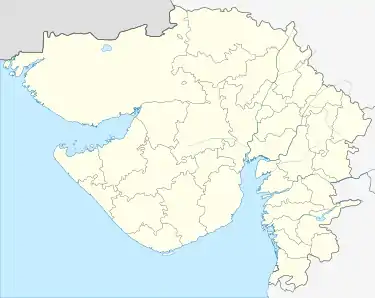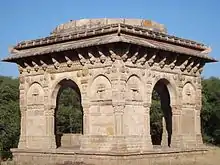Nagina Mosque
Nagina Mosque (meaning 'Jewel Mosque') is a mosque in Champaner, Gujarat, India. It was built during the time of Mahmud Begada, in the 15th century, as were several other masjids, such as the Kevada, Bawaman, Ek Minar, Jama, Khajuri, and Shahar Ki.[1] It has minarets, globe-like domes, and narrow stairs.[2] It is part of the Champaner-Pavagadh Archaeological Park, a UNESCO World Heritage Site.[3]
| Nagina Mosque | |
|---|---|
 Front elevation of Nagina Masjid, Champaner | |
| Religion | |
| Affiliation | Islam |
| District | Panchmahal |
| Ecclesiastical or organizational status | Ruins |
| Leadership | Muhmad Begada |
| Year consecrated | 15th century |
| Status | Part of UNESCO Heritage Park |
| Location | |
| Location | |
| Municipality | Champaner |
| State | Gujarat |
 Shown within Gujarat | |
| Geographic coordinates | 22.4859°N 73.5371°E |
| Architecture | |
| Type | Mosque |
| Style | Blend of Hindu-Muslim Architecture |
| Completed | 15th century |
| Specifications | |
| Dome(s) | Three |
| Minaret(s) | Three |
| Materials | Rubble Masonry |
Geography
The masjid is about 0.75 miles (1.21 km) to the south of the citadel, and 1,800 feet (550 m) north of the Bhadr.[4] The Kajuri Masjid is west of the Nagina and the Kevada is to the north-northwest. A small lake is situated considerably to the north.[4] After James Burgess and Henry Cousens wrote descriptions of the Nagina, Kevada, and Jama Masjids, roads were built to reach them.[5]


Architecture
The masjid is a large monument built on a high-rise plinth with a large open courtyard in front. The building was constructed of pure white stone.[6] At the main entrance, the masjid is marked by minarets, which have intricate and elegant carvings; as in other masjids, like Kevada Masjid, it has floral designs in its niches. Three large domes rise over the main prayer hall, above decorative columns and windows. The architecture also features a series of beautifully designed projecting corbels and a projecting cornice, and is decorated with geometric motifsm both inside and outside at the platform level. The main prayer hall rises two storeys and has a balcony.[7][8]
Grounds
Within the precincts of the masjid there are a few brick structures and step wells. An elegant domed mausoleum is situated in front of the mosque to the northeast.[4] The cenotaph has openings on all four directions; its frontage, columns and niches are decorated with carved floral and geometrical designs. The cenotaph's central dome has disappeared.
Restoration
Initial restoration works were carried out in the 1890s.[9] The pillars of Nagina Masjid and Lila Gumbaj Ki Masjid were subject to deterioration due to wind, humidity and moisture (bio-deterioration) and the stones were “pulverized”. Further pulverization was prevented by spraying on OH-100 (ethyl silicate) and also in a few cases deteriorated areas were filled with stone powder mixed with OH-100.[3] Other treatment measures included removing insoluble salts using a 2% solution of sodiumhexa meta phosphate, ferrous salts with a 2% solution of EDTA and removing bat excreta with a 5% solution of liquid ammonia and non-ionic detergent followed by a second stage of treatment by applying a mixture of ammonium carbonate and ammonium bicarbonate, with EDTA as an additive. Micro-vegetation growth were carefully removed by brushing with soft nylon brushes sprayed with an aqueous solution of 3% ammonia and 1% non-ionic detergent, which was later removed by washing with a large quantity of water.[3]
See also
References
- Congress (2003). Proceedings of the Indian History Congress. Indian History Congress. p. 342. Retrieved 29 September 2012.
- Singh, Sarina (1 September 2009). India. LP. pp. 742–. ISBN 978-1-74179-151-8. Retrieved 29 September 2012.
- "Champaner-Pavagarh World Heritage Site– Gujarat" (PDF). UNESCO Organization.
- Burgess, James; Cousens, Henry (1897). Revised lists of antiquarian remains in the Bombay Presidency: and the native states of Baroda, Palanpur, Radhanpur, Kathiawad, Kachh, Kolhapur, and the southern Maratha minor states (Public domain ed.). Printed at the Government central press. pp. 95–. Retrieved 30 September 2012.
- Khanna, Amar Nath (1 February 1992). Archaeology of India: retrospect and prospect. Clarion Books. p. 223. ISBN 978-81-85120-17-1. Retrieved 29 September 2012.
- Bombay, (India : State) (1887). Volume 3 of Gazetteer of the Bombay Presidency, Bombay (India :State). Printed at the Government Central Press. pp. 304–309. Retrieved 23 September 2012.
- "World Heritage Sites - Champaner - Monuments at Champaner". Archaeological Survey of India. Archived from the original on 1 May 2012. Retrieved 28 September 2012.
- "Mosques of Champaner". Official Web site of Government of Gujarat Tourism. Archived from the original on 16 October 2011. Retrieved 29 September 2012.
- Bombay (India : State). General Dept (1897). Archaeology, Progress Report. Bombay: Archaeological Survey of India. Western Circle. p. 8. Retrieved 1 October 2012.
| Wikimedia Commons has media related to Nagina Masjid (Champaner). |
